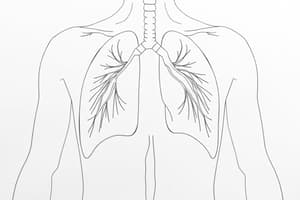Podcast
Questions and Answers
What are the four main factors that affect the efficiency of gas exchange in the lungs?
What are the four main factors that affect the efficiency of gas exchange in the lungs?
- Pressure, Solubility, Thickness of the respiratory membrane, Membrane area (correct)
- Temperature, Metabolic products, pH, 2,3-BPG
- Ventilation, Perfusion, Bulk Flow, Diffusion
- None of the above
What are the three ways that carbon dioxide is transported in the blood?
What are the three ways that carbon dioxide is transported in the blood?
- Bicarbonate buffer system, bound to haemoglobin, dissolved in plasma (correct)
- Diffusion, Bulk flow, Pressure gradient
- Solubility, Temperature, pH
- None of the above
What is the name of the law that states the total atmospheric pressure is the sum of all the gases?
What is the name of the law that states the total atmospheric pressure is the sum of all the gases?
Dalton's Law
The higher the partial pressure of oxygen, the lower the affinity of haemoglobin for oxygen.
The higher the partial pressure of oxygen, the lower the affinity of haemoglobin for oxygen.
What is the Bohr Effect?
What is the Bohr Effect?
What condition refers to the lower affinity of haemoglobin for oxygen?
What condition refers to the lower affinity of haemoglobin for oxygen?
The movement of gases through the body is primarily due to:
The movement of gases through the body is primarily due to:
The respiratory membrane is composed of ______ layers.
The respiratory membrane is composed of ______ layers.
Match the following respiratory terms with their corresponding descriptions.
Match the following respiratory terms with their corresponding descriptions.
Flashcards
String
String
A sequence of characters, such as letters, numbers, and symbols.
Binary representation
Binary representation
A way to store and represent data as numbers, making it easier for computers to process.
Algorithm
Algorithm
A set of instructions that tells a computer what to do.
Flowchart
Flowchart
Signup and view all the flashcards
Data structure
Data structure
Signup and view all the flashcards
Modular programming
Modular programming
Signup and view all the flashcards
Debugging
Debugging
Signup and view all the flashcards
Robustness
Robustness
Signup and view all the flashcards
Compilation
Compilation
Signup and view all the flashcards
Software testing
Software testing
Signup and view all the flashcards
Study Notes
Gas Exchange and Transport
- Gas exchange involves the movement of gases like oxygen (O2) and carbon dioxide (CO2) between the alveoli, blood and tissues.
- The process involves two mechanisms: bulk flow and diffusion.
- Gases move from areas of high pressure to low pressure.
Partial Pressures of Gases
- Dalton's Law states that the total pressure of a mixture of gases is the sum of the partial pressures of the individual gases.
- Partial pressure refers to the pressure exerted by an individual gas in a mixture.
Alveolar Gas Exchange
- Enhaled air has a partial pressure of O2 greater than in the blood.
- Oxygen diffuses from the alveoli in the lungs into the blood.
- Carbon dioxide diffuses from the blood into the alveoli, to be exhaled.
Transport of Gases around the Body
- Oxygenated blood travels to systemic tissues where oxygen is unloaded.
- Blood picks up CO2 from tissues and carries it to the lungs for exhalation.
- Blood carries oxygen and CO2 around the circulatory system.
Factors Governing Gas Exchange
- Pressure Gradients: Gases move down their pressure gradients. High pressure areas to low pressure areas. A larger difference in pressure causes faster gas exchange.
- Solubility: CO2 is more soluble in water than O2, so it is transported more efficiently in the blood.
- Membrane Thickness: A thinner membrane allows more rapid gas diffusion. Diseases can thicken this membrane, slowing exchange.
- Membrane Area: A larger surface area increases the rate of gas exchange.
Factors Affecting Alveolar Gas Exchange
- Efficiency of gas exchange depends on the time taken to load/unload O2 and CO2 in red blood cells.
- This time is about 0.25 seconds at rest and 0.3 seconds during exercise.
- Variables like pressure gradients, solubility, thickness and surface area of the respiratory membrane influence gaseous exchange rates.
Oxygen Transport
- Red blood cells (RBCs) contain haemoglobin (Hb) that binds to oxygen.
- Oxygen binds reversibly and cooperatively to Hb.
- A large amount of O2 is carried by this method.
- Only about 1.5% of oxygen is dissolved in blood.
Haemoglobin
- Each Hb molecule can bind up to four O2 molecules.
- The binding of oxygen to Hb is cooperative. Binding of the first O2 molecule to Hb facilitates binding of the other O2 molecules.
- The shape of the haemoglobin dissociation curve shows how the percent saturation of haemoglobin changes with partial pressure of oxygen.
Carbon Dioxide Transport
- About 75% of CO2 is transported as bicarbonate ions (HCO3−) in the blood.
- About 20% of CO2 binds to haemoglobin (as carbamino compounds)
- About 5% of CO2 is dissolved in the blood.
- The chloride shift maintains electrical neutrality.
Chemoreceptors
- Central and peripheral chemoreceptors detect changes in blood pH, pCO2, and pO2.
- These receptors send signals to the respiratory center to adjust breathing rate.
Studying That Suits You
Use AI to generate personalized quizzes and flashcards to suit your learning preferences.




